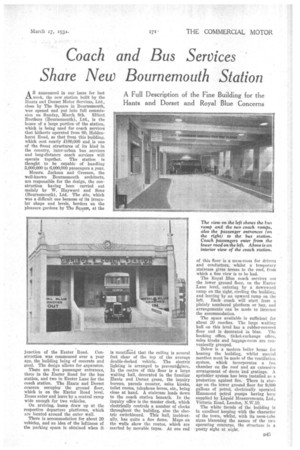Coach and Bus Services Share New Bournemouth Station
Page 115

If you've noticed an error in this article please click here to report it so we can fix it.
AS announced in our issue for last week, the new station built by the Hants and Dorset Motor Services, Ltd., close by The Square in Bournemouth, was opened and put into full commission on Sunday, March_ 8th. Elliott Brothers (Bournemouth), Ltd., is the lessee of a large portion of the station, which is being u,sed for coach services that hitherto operated from 60, Holdenburst Road, so that from this building, which cost nearly £100,000 and_is one of the finest structures of its kind in the country, inter-urban bus services and long-distance coach services will operate together. The station is thought to be capable of handling 5,000,000 to 6,000,000 passengers a year.
Messrs. Jackson and Greenen, the well-known Bournemouth architects, are responsible for the design, the construction having been carried out mainly by W. Hayward and Sons (Bournemouth), Ltd. The site, which was a difficult one because of its irregular shape and levels, borders on the pleasure gardens by The Square, at the junction of the Exeter Road. Construction was commenced over a year ago, the building being of concrete and steel. The design allows for expansion.
There are five passenger entrances, three in the Exeter Road for the bus station, and two in Exeter Lane for the coach station. The Hants and Dorset concern occupies the ground flocrr, which is on the Exeter Road level. Buses enter and leave by a centred ramp wide enough for two vehicles.
On arriving, buses draw up at the respective departure platforms, which are located around the outer wall.
There is accommodation for about 20 vehicles, and an idea of the loftiness of the parking space is obtained when it is mentitned that the ceiling is several feet clear of the top of the average double-decked vehicle. The electric lighting is arranged to preventiglare. In the centre of this floor is a large waiting hall, decorated in the familiar Hants and Dorset green, the inquiry bureau, parcels counter, sales kiosks, toilet rooms, telephone boxes, etc., being close at hand. A staircase leads down to the coach station beneath. In the inquiry office is the master clock, which electrically controls a number of clocks throughout the building, also the electric switchboard. This hall, incidentally, has quite a fine dome. Maps on the walls show the routes, which are marked by movable tapes. At one end of this floor is a mess-room for drivers and conductors, whilst a temporary staircase mixes access to the roof, from which a fie view is to be had.
The Royal Blue coach services use the lower ground floor, on the Exeter Lane level, entering by a. downward ramp on the right, circling the building, and leaving by an upward ramp on the left. Each coach will start from a plainly numbered platform or bay, and arrangements can be made to increase the accommodation.
The space available is sufficient for about 20 coaches. The large waiting hall on this level has a rubber-covered floor and is decorated in blue. The booking office, ticket-exchange office, sales kiosks and luggage-room are conveniently grouped.
Below is a modern boiler house for heating the building, whilst special mention must be made of the ventilation system, which incorporates a fan chamber on the roof and an extensive arrangement of ducts and gratings. A sprinkler system has been installed as a protection against fire. There is storage on the lower ground floor for 9,000 gallons of petrol, electrically operated Hammond petrol pumps having been supplied by Liquid Measurements, Ltd.; Victoria Road, London, NAVA°.
The white facade of the building is in excellent keeping with the character of the town, whilst, with its neon-tube signs blazoning the names of the two operating concerns, the structure is a pretty sight at night.
























































































































































































